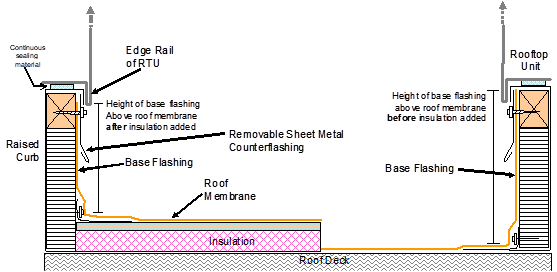
The Energy Code offers prescriptive approaches and a performance approach to additions and alterations, but they do not apply to repairs. See §141.0(a)|topic=(a) Additions. Additions shall meet either Item 1 or 2 below. and §100.1(b) for detailed definitions.
A. Addition is a change to an existing building that increases conditioned floor area and volume. When an unconditioned building or unconditioned part of a building adds heating or cooling so that it becomes newly conditioned for the first time, this area is treated as an addition.
B. Alteration is a change to an existing building that is not an addition. An alteration could include a new HVAC system, lighting system, or change to the building envelope, such as a new window. Roof replacements (reroofing) and reconstructions and renewal of the roof are considered alterations and are subject to all applicable Energy Code requirements. For alterations, the compliance procedure includes:
1. The prescriptive envelope component approach.
2. The existing-plus-alteration performance approach.
3. The existing-plus-addition-plus alteration performance approach.
C. Repair is the reconstruction or renewal of any part of an existing building for maintenance. Repairs must not increase the preexisting energy consumption of the repaired component, system, or equipment; otherwise, it is an alteration.
For example, a repair could include the replacement of a pane of glass in an existing multi-lite window without replacing the entire window.
Additions and alterations to the building envelope must meet the prescriptive insulation requirements in §141.0 or comply using the performance compliance approach.
All additions must meet the applicable mandatory requirements from the following Energy Code sections:
•§110.6 − Mandatory Requirements for Fenestration Products and Exterior Doors
•§110.7 − Mandatory Requirements for Joints and Other Openings
•§110.8 − Mandatory Requirements for Insulation and Roofing Products (Cool Roofs)
•§120.7|topic=SECTION 120.7 – MANDATORY INSULATION REQUIREMENTS− Mandatory Requirements for Insulation.
All alterations must meet the mandatory requirements of §110.6, §110.7, and §110.8.
A. Wall Insulation
Insulation for walls that separate conditioned space from either unconditioned space or ambient air shall comply with the mandatory requirements of §141.0(b)1B. This section provides two options for wall insulation compliance: either a minimum insulation R-value or a maximum assembly U-factor. The mandatory requirements are determined by the wall type per Table 3-17:
Table 3-17 Wall Insulation for Alterations
|
Wall Assembly Type |
Minimum R-value |
Maximum U-factor |
|
Metal buildings |
R-13 |
0.113 |
|
Metal-framed walls |
R-13 |
0.217 |
|
Wood-framed walls and others |
R-11 |
0.110 |
|
Spandrel panel and curtain walls |
R-4 |
0.280 |
Light mass and heavy mass walls do not have mandatory requirements for minimum R-value and maximum U-factor.
B. Floor Insulation
Insulation for floors that separate conditioned space from either unconditioned space or ambient air shall comply with the mandatory requirements of §141.0(b)1C. This section provides two options for compliance with the mandatory requirements: either a minimum insulation R-value or a maximum assembly U-factor. For floors, the mandatory requirements are determined by both building type and floor type.
Table 3-18 Floor Insulation for Alterations
|
Floor Assembly Type |
Minimum R-value |
Maximum U-factor |
|
Raised framed floors |
R-11 |
0.071 |
|
Raised mass floors in high rise, hotel and motel |
R-6 |
0.111 |
Raised mass floors in all other occupancies - No minimum U-factor is required.
For more details on the prescriptive requirements, see Section 3.2 for envelope requirements and Section 3.3 for fenestration requirements.
§141.0(a)1|tag=1__Prescriptive_approach_
Prescriptive compliance for the building envelope of additions is addressed in §141.0(a)1|tag=1__Prescriptive_approach_ and §140.3. §140.3(a) provides prescriptive compliance alternatives for the building envelope, including tradeoffs between roofing insulation and the solar reflectance of roofing products (cool roofs) in Table 140.3-A. Tradeoffs between other envelope components are not allowed in the prescriptive method. The performance method may be used for tradeoff for both newly constructed buildings and alterations.
All additions must also comply with §140.3(c), Minimum Skylight Area, for large, enclosed spaces in buildings with three or fewer stories.
Alternatively, the addition may meet compliance by using the performance compliance approach of §140.1|topic=SECTION 140.1 – PERFORMANCE APPROACH\: ENERGY BUDGETS, which compares the TDV energy (space conditioning, lighting, and water heating) of the proposed building addition to a TDV energy budget that complies with prescriptive requirements.
In general, any alteration to an existing building that involves changes to a portion of the building envelope triggers the Energy Code. The prescriptive requirements for alterations to building envelopes are in §141.0(b)2A and 141.0(b)2B of the Energy Code.
The altered components of the envelope shall meet the applicable mandatory requirements of §110.6, §110.7 and §110.8.
A. Fenestration
When fenestration is altered that does not increase the fenestration area, it shall meet the requirements of Table 141.0-A of the Energy Code (Table 3-19) based on climate zone.
When new fenestration area is added to an alteration, it shall meet the requirements of §140.3(a) and TABLE 140.3-B, C or D of the Energy Code. Compliance with §140.3(a) is not required when the fenestration is temporarily removed and then reinstalled.
In cases where small amounts of fenestration area are changed, several options exist.
•If less than 150 ft² of fenestration area is replaced throughout the entire building, then the Energy Code require that only the U-factor requirements in TABLE 140.3-B, C, or D are met. The SHGC, RSHGC, or VT requirements need not be met.
•The same requirements and exceptions apply if 50 ft² or less of fenestration (or skylight) area is added. A typical example of this may be changing a door from a solid door to a glass door.
Table 3-19: Altered Window Maximum U-Factor and Minimum RSHGC and VT
|
Climate Zone |
1 |
2 |
3 |
4 |
5 |
6 |
7 |
8 |
9 |
10 |
11 |
12 |
13 |
14 |
15 |
16 |
|
U-factor |
0.47 |
0.47 |
0.58 |
0.47 |
0.58 |
0.47 |
0.47 |
0.47 |
0.47 |
0.47 |
0.47 |
0.47 |
0.47 |
0.47 |
0.47 |
0.47 |
|
SHGC |
0.41 |
0.31 |
0.41 |
0.31 |
0.41 |
0.31 |
0.31 |
0.31 |
0.31 |
0.31 |
0.31 |
0.31 |
0.31 |
0.31 |
0.31 |
0.41 |
Note : For VT See TABLE 140.3-B, C, and D for all Climate Zones
Energy Code, Table 141.0-A
Example 3-18
Question:
The envelope and space conditioning system of an office building with 120,000 square feet of conditioned floor area is being altered. The building has 24,000 square feet of vertical fenestration. Which of the following scenarios does the NFRC label certificate requirement apply to?
1. Existing glazing remains in place during the alteration.
2. Existing glazing is removed, stored during the alteration period, and then reinstalled (glazing is not altered in any way).
3. Existing glazing is removed and replaced with new site-built glazing with the same dimensions and performance specifications.
4. Existing glazing on the north façade (total area 800 square feet) is removed and replaced with site-built fenestration.
Answer:
NFRC label certificate or California Energy Commission default values requirements do not apply to Scenarios 1 and 2 but do apply to Scenario 3.
1. Requirement does not apply because the glazing remains unchanged and in place.
2. Exception to §110.6(a)1 applies to fenestration products removed and reinstalled as part of a building alteration or addition.
3. Use either NFRC label certificate or use Tables 110.6-A and 110.6-B default values; applies in this case as 24,000 ft² of new fenestration is being installed.
4. Since the site-built vertical fenestration area is being used as part of an alteration use either the NFRC label certificate, the applicable default U-factor or SHGC set forth in Reference Nonresidential Appendix NA6, or default values from Tables 110.6-A and 110.6-B.
B. Walls and Floors
All nonresidential building alterations involving exterior walls, demising walls, external floors, or soffits must either comply as a component with the requirements in TABLE 140.3-B, C, or D in the Energy Code, or by approved compliance software following the rules of the ACM Reference Manual that demonstrates that the overall TDV energy use of the altered building complies with the Energy Code.
C. Air Barrier
If 25 percent or more of the building envelope’s wall area is altered it needs to meet the air barrier design and material requirements for newly constructed buildings. See Section 3.2.3.2 for detailed guidance on the air barrier requirements for newly constructed buildings and how to perform the blower door testing.
If a blower door test is performed and the air leakage rate exceeds 0.4 cfm/ft2 a Visual Inspection and Diagnostic Evaluation must be completed in accordance with Nonresidential Appendix NA5.7 to find the sources of excessive leakage. The leaks shall then be sealed. An additional report identifying the corrective actions taken to seal air leaks should be submitted to the building owner and code official. Retesting is not needed.
Additions that do not have a completely separate air barrier from the existing building – there is not wall separating the two – shall be temporarily partitioned in order to conduct the air leakage test if the pressurization test is chosen to comply with the requirements of 140.3(a)9C
D. Roofs
Existing roofs being replaced, recovered, or recoated for nonresidential, high-rise residential and hotels/motels buildings shall meet the requirements of §110.8(i). When the alteration is being made to 50 percent or more of the existing roof area or when more than 2,000 ft2 of the roof is being altered, (whichever is less) the requirements apply. When a small repair is made, these requirements do not apply. For example, the requirements for roof insulation would not be triggered if the existing roof surface were overlaid instead of replaced.
These requirements apply to roofs over conditioned, non-process spaces even if the building has a portion that is a process space. These roof areas can be delineated by the fire separation walls between process areas and conditioned, non-process areas.
The California Building Code (CBC) and local amendments place limitations on the number of new roof covering layers that are allowed to overlay an existing roof covering in accordance with CBC 1510. When this limit is reached, the existing roof covering must be removed down to the roof deck or insulation recover boards.
E. Roof Insulation
When a roof is replaced or recovered, and the alteration complies with the prescriptive requirements for roofing products, the altered roof area shall be insulated to the levels specified in Table 141.0-C of the Energy Code (Table 3-20).
Roof replacement and roof recover are defined in Title 24, Part 2, Chapter 2 – Definitions. A roof replacement is the process of removing the existing roof covering, repairing any damaged substrate and install a new roof covering. A roof recover is the process of installing an additional roof covering over a prepared existing roof covering without removing the existing roof covering. Roof recovers are typically a less expensive option but can only be performed if the existing roof is in good condition. Usually, one roof recover is allowed before the roof needs to be replaced. Title 24, Part 2, Chapter 15 does not permit roof recovers where the existing roof or roof covering is water soaked or has deteriorated to the point where it is not an adequate base for additional roofing; where the existing roof covering is slate, clay, cement, or asbestos-cement title; or where the existing roof has two or more applications of any type of roof covering.
If a roof has an existing coating, the application of a coating for the purposes of renewal or maintenance (i.e., a roof recoat) is exempt from the low-sloped roof insulation requirements of Section 141.0(b)2Bii and 180.2(b)1Aiii. Roof recoats that are part of a roof recover are considered a roof recover as defined in Section 100.1 and are required to meet the insulation requirements for roof recovers in Section 141.0(b)2Bii and 180.2(b)1Aiii.
The amount of insulation required varies by climate zone and building type. The requirements are given in terms of a continuous layer of insulation (usually installed on top of the roof deck) or an overall roof U-factor based on the default tables and calculation method in Reference Appendices, Joint Appendix JA4|topic=Appendix JA4 – U-factor\, C-factor\, and Thermal Mass Data. The U-factor method provides more flexibility, as insulation can be added continuously on top of the roof deck, below the roof deck between roof joists, or a combination of insulation above and below the roof deck.
Table 3-20: Nonresidential Insulation Requirements for Roof Alterations
|
Climate Zone |
Continuous Insulation R-value |
U-Factor |
|
1-5 and 9-16 |
R-23 |
0.037, with at least R-10 above deck |
|
6-8 |
R-17 |
0.047, with at least R-10 above deck |
Source: Energy Code, Table 141.0-C
For roof alterations, when roofs are replaced or recovered and meet the roofing products requirements in §141.0(b)2Bi or ii, the altered area must be insulated to levels specified in the Energy Code, Table 141.0-C. For nonresidential buildings, this level is:
•R-17 or R-23 (depending on climate zone) with the use of continuous insulation; or
•U-0.047 or U-0.037 (depending on climate zone) if the insulation is a combination of above deck continuous insulation and cavity insulation. Under the U-factor option, at least R-10 of continuous insulation must be installed above the roof deck.
Exceptions to §141.0(b)2Bii:
•Roof recovers with new R-10 insulation added above deck do not need to be insulated to the level specified in Table 141.0-C.
•When mechanical equipment located on the roof will not be disconnected and lifted as part of the roof replacement, insulation added may be the greater of R-10 or the maximum installed thickness that will allow the distance between the height of the roof membrane surface to the top of the base flashing to remain in accordance with the manufacturer’s instructions.
o Increasing the elevation of the roof membrane by adding insulation may also affect roof drainage. The Energy Code allows tapered insulation to be used that has a thermal resistance less than that prescribed in Table 141.0-C at the drains and other low points, provided that the thickness of insulation is increased at the high points of the roof so that the average thermal resistance equals or exceeds the value that is specified in Table 141.0-C.
16. When insulation is added on top of a roof, the elevation of the roof membrane is increased. When insulation is added to a roof and the curb height (counterflashing for walls) is unchanged (Figure 3-30), the height of the base flashing above the roof membrane will be reduced. In some cases, when the overhanging edge of the space-conditioning equipment is very close to the side of the curb, this may also limit how far up the curb the base flashing may be inserted. Many manufacturers and the National Roofing Contractors Association (NRCA) recommend maintaining a minimum base flashing height of 8 inches above the roofing membrane.
When adding insulation on top of a formerly uninsulated or under-insulated roof, consider the effects on base flashing height. It may be desirable to increase curb heights or counterflashing heights to maintain the same or higher base flashing heights above the roof membrane. In other cases, where leak risk is low, ask the roofing manufacturer for a variance on installation requirements for a roofing warranty; this may require additional waterproofing measures to obtain the manufacturer’s warranty. Installing insulation under the roof deck when access is feasible doesn’t change the base flashing height and, in some cases, may be the least expensive way to insulate the roof.
Figure 3-30: Base Flashing on Rooftop Unit Curb Detail

F. Roof Products
1. Thermal Emittance and Aged Solar Reflectance Prescriptive Requirements
For nonresidential buildings, the prescriptive requirements for roofing products are:
•Low-sloped roofs in climate zones 1 through 16 have a required minimum aged solar reflectance of 0.63 and a minimum thermal emittance of 0.75, or a minimum SRI of 75.
•Steep-sloped roofs in climate zones 1 and 3 have a minimum aged solar reflectance of 0.20 and a minimum thermal emittance of 0.75, or a minimum SRI of 16. climate zones 2 and 4 through 16 have a minimum aged solar reflectance of 0.25 and a minimum emittance of 0.80, or a minimum SRI of 23.
Exception for nonresidential buildings: an aged solar reflectance less than 0.63 is allowed, provided that additional insulation is installed. (Table 3-21)
For hotel and motel buildings, the prescriptive requirements for roofing products are:
•Low-sloped roofs in climate zones 10, 11, 13, 14 and 15 have a required minimum aged solar reflectance of 0.55 and a minimum thermal emittance of 0.75, or a minimum SRI of 64.
•Steep-sloped roofs in climate zones 2 through 15 have a required minimum aged solar reflectance of 0.20 and a minimum thermal emittance of 0.75, or a minimum SRI of 16.
Exceptions for hotel and motel buildings:
1. For roof area covered by building integrated photovoltaic panels and building integrated solar thermal panels, roofing products are not required to meet the minimum requirements for solar reflectance, thermal emittance, or SRI.
2. For roof constructions that have thermal mass over the roof membrane with a weight of at least 25 lb/ft² roofing products are not required to meet the minimum requirements for solar reflectance, thermal emittance, or SRI.
U-factors measure the thermal performance of the entire roof assembly, both above and below the roof deck. Utilizing U-factors provides flexibility. Trade-offs can be made by installing additional insulation continuously above the roof deck, between the joists below the roof deck, or a combination of both approaches. Table 141.0-B (Table 3-21) shows the overall roof U-factors trade-off requirements, by climate zones.
Table 3-21: Roof/Ceiling Insulation Trade-Off for Aged Solar Reflectance
|
Aged
Solar |
Climate
Zone |
Climate
Zone |
|
0.62 - 0.60 |
0.043 |
0.035 |
|
0.59 - 0.55 |
0.041 |
0.034 |
|
0.54 - 0.50 |
0.038 |
0.031 |
|
0.49 - 0.45 |
0.034 |
0.029 |
|
0.44 - 0.40 |
0.032 |
0.028 |
|
0.39 - 0.35 |
0.029 |
0.026 |
|
0.34 - 0.30 |
0.028 |
0.025 |
|
0.29 - 0.25 |
0.026 |
0.024 |
Energy Code, Table 141.0-B
Table 141.0-B of the Energy Code not only takes account of the amount of insulation necessary to compensate for using a noncompliant roofing product, it also accounts for the minimum insulation requirements that apply to roof alterations generally.
Example 3-19
Question:
What are the Energy Code requirements for cool roofs when reroofing a low-sloped roof on an unconditioned warehouse containing conditioned office space?
Answer:
Scenario 1.
There is either directly or indirectly conditioned space under the roof. The cool roof requirements apply to just the portion(s) of the warehouse roof over the conditioned space(s). The rest of the roof (over unconditioned warehouse space) is not required to be a cool roof.
The walls of the conditioned space go all the way up to the underside of the warehouse.
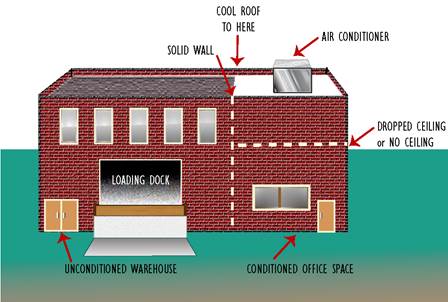
Source: California Statewide CASE Team
Scenario 2.
The walls of the conditioned space do not reach all the way to the warehouse roof. The roof requirements do not apply because the space directly below the roof is unconditioned and communicates with the rest of the unconditioned portion of the warehouse.
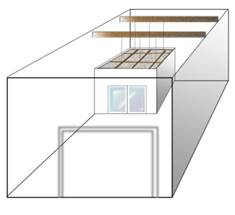
Example 3-20
Question:
I have a barrel roof on nonresidential conditioned building that needs to be reroofed. Must I follow the Energy Code roofing product requirement?
Answer:
Yes, the roof would need to meet the aged solar reflectance and thermal emittance for a steep-sloped roof. Although a barrel roof has both low-sloped and steep-sloped roofing areas, the continuous gradual slope change allows the steep-sloped section of the roof to be seen from ground level. Barrel roofs only need to meet the steep-sloped requirement for the entire roof area.

Example 3-21
Question 1:
40 percent of the low-sloped roof on a 500 ft by 100 ft retail building in Concord, California (CZ12,) is being reroofed. The roofing is removed down to the roof deck, and there is no insulation. Must insulation be added before reroofing?
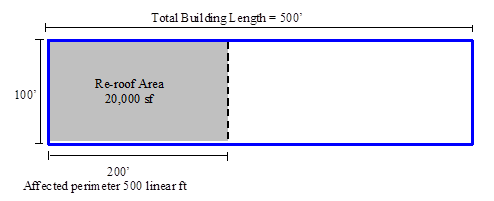
Answer 1:
Yes, §141.0(b)2B requires when either 50 percent (or more) of the roof area or 2,000 ft² (whichever is less) is reroofed down to the roof deck or recover boards, that insulation be installed if the roof has less than the insulation in Energy Code Table 141.0-C. Though the reroofing covers only 40 percent of the roof area, the requirements still apply because the 20,000 ft² of replacement roof area is greater than the threshold area of 2,000 ft². The roof does not have any insulation and, therefore, is required to add insulation. As per Energy Code, Table 141.0-C Insulation Requirements for Roof Alterations, for nonresidential buildings in climate zone 12, the requirement for insulation is either R-23 continuous insulation (e.g., 4-inches of polyisocyanurate (polyiso) rated at R-5.7/inch) or an effective roof U-factor of 0.037 Btu/h•ft²•°F with at least R-10 continuous insulation installed above deck.
Question 2:
If the building is in San Francisco, would the insulation requirements be different on the building?
Answer 2:
No. San Francisco (as shown in Reference Appendices, Joint Appendix JA2|topic=Appendix JA2 – Reference Weather/Climate Data.) is in climate zone 3. Per Table 141.0-C from §141.0(b)2B, the insulation requirement for roof alterations for nonresidential buildings in climate zone 3 is R-23 or a U-factor of 0.037 with at least R-10 continuous insulation installed above deck.
Example 3-22
Question 1:
A nonresidential building is having 5,000 ft² of roofing replaced in Richmond (climate zone 3). During roofing replacement the roof deck will be exposed. This building has a rooftop air conditioner that is sitting on an 8-inch-high curb above the roof membrane level. The roof is uninsulated. If the rooftop air-conditioner unit is not disconnected and not lifted off the curb during reroofing, is adding insulation required? If so, how much?
Answer 1:
Yes, the only time insulation is not required to be added is if the roof already meets the insulation requirements in Energy Code Table 141.0-C. However, the exception to §141.0(b)2Bii allows for less insulation to be installed if the space conditioning equipment is not disconnected and lifted during reroofing. In this case, the requirements for adding insulation are limited to the greater of R-10 (e.g., 1.75 inches of polyisocyanurate insulation rated at R-5.7/inch) or the maximum installed thickness that will allow the distance between the height of the roof membrane surface to the top of the base flashing to remain in accordance with the manufacturer’s instructions. Ask the roofing manufacturer what the lowest curb height is that they will provide a warranty for: if it is 6.25 inches or lower (8-inch curb height – 1.75 inches of polyiso), install the maximum amount of insulation to remain in accordance with the manufacturer’s instructions. If it is higher than 6.25 inches and therefore it is not possible to install R-10 or greater, the space conditioning must be disconnected and lifted, the curb must be replaced or a curb extension added, and the full insulation required by Energy Code Table 141.0-C must be added, in this case R-23 or U-0.037 with at least R-10 above deck.
Question 2:
What if the rooftop air conditioner is lifted temporarily during reroofing to remove and replace the roofing membrane? How much i added insulation is required?
Answer 2:
The insulation required by Energy Code Table 141.0-C must be added, in this case R-23 or U-0.037 with at least R-10 above deck.
When the rooftop unit is lifted as part of the reroofing project, the incremental cost of replacing the curb or adding a curb extension is reduced and therefore the exception does not apply.
Thus, to maintain the 8-inch base flashing height, one can replace the curb or add a curb extension before reinstalling the roof top unit. Alternatively, one can ask for a roofing manufacturer’s variance to the warranty from the typical minimum required 8 inches base flashing height above the roof membrane to the reduced amount after the roof insulation is installed. The specific risk of roof leakage at a given site has to be considered carefully before reducing the base flashing height. An alternative method of compliance that does not affect base flashing heights is to add insulation below the roof deck to the overall U-factor levels given in Table 141.0-C of §141.0(b)2B.
Example 3-23
Question:
A nonresidential building is having 5,000 ft² of roofing replaced. During roofing replacement, the roof deck will be exposed. This building has several unit skylights that are sitting on an 8–inch-high (20 cm) curb above the roof membrane level. The roof is uninsulated. Is added insulation required?
Answer:
Yes, insulation is required. There are no exceptions for skylights. Removing a unit skylight and increasing its curb height is substantially less effort than that for space-conditioning equipment.
Example 3--24
Question 1:
A building has low-sloped roofs at two elevations. One roof is 18 feet above grade and has a total area of 5,000 ft²; the other roof is 15 feet above grade and has a total area of 3,000 ft². Both roofs are uninsulated and are above conditioned space. If 1,800 ft² of the 3,000 ft² roof is being reroofed and the roof deck is exposed, is that portion of the roof required to be insulated and be a cool roof (high reflectance and emittance)?
Answer 1:
Yes, the reroofed section of the roof must be insulated and have a cool roof. Section 141.0(b)2B requires insulation and cool roofs for low-sloped roof alterations if the alteration is greater than 2,000 ft² or greater than 50 percent of the roof area. Since 1,800 ft² is 60 percent of 3,000 ft², the cool roof and insulation requirements apply.
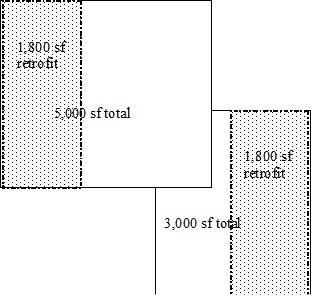
Question 2:
If the 1,800 ft² of roofing being replaced was on the 5,000 ft² uninsulated roof, would the portion of the roof replaced be required to be a cool roof and have insulation installed?
Answer 2:
No. The 1,800 ft² retrofit is 36 percent of the 5,000 ft² roof. Thus, the 1,800 ft² retrofit is less than 50 percent of the roof area and it is less than 2,000 ft²; thus, it is not required to comply with the insulation and cool roof requirements in §141.0(b)2B.
Example 3--25
A 10,000 ft² building in climate zone 10 with an uninsulated roof above conditioned space is having roofing removed so that the roof deck is exposed. There are two rooftop units on this section of the roof that is being altered. One rooftop unit has a curb with a 9-inch base flashing, and the other has a modern curb with a 14-inch base flashing. Consider the following three scenarios:
Question 1: The rooftop unit with the 9-inch base flashing is disconnected and lifted during reroofing. However, the rooftop unit on the curb with the 14-inch (36 cm) base flashing is not lifted. In this situation, is the insulation added limited to the greater of R-10 or the maximum installed thickness that will allow the distance between the height of the roof membrane surface to the top of the base flashing on the unit with the lower curb to remain in accordance with the manufacturer’s instructions?
Answer 1:
No. The unit with the 9-inch base flashing was disconnected and lifted and thus it does not qualify for the exception to §141.0(b)2Bii. There is plenty of room to meet the insulation requirements in Energy Code Table 141.0-C in any climate zone without impacting the unlifted rooftop unit with a 14-inch curb.
Question 2:
The rooftop unit with the 9-inch base flashing is not disconnected and lifted during reroofing. In this situation Does an exception apply for the amount of insulation that must be added?
Answer 2:
Yes. The unit with the 9-inch (23 cm) base flashing was not disconnected and lifted, and thus it qualifies for the exception 2 to §141.0(b)2Bii. This should be handled in the same way as Example 3-22, Question 1, above.
Question 3:
In Question 2, does this reduced amount of required insulation apply only to the area immediately surrounding the unlifted unit or to the entire roof?
Answer 3:
The reduced amount of insulation applies to the entire roof. However, if a building has multiple roofs, the limitation would apply only to any roof with a rooftop unit that was not disconnected and lifted and that has a low curb.
Example 3--26
Question:
In reroofing, is existing roofing that is a rock or gravel surface equivalent to a gravel roof over an existing cap sheet, and therefore qualify for the exceptions in 140.3(a)Ai?
Answer:
No, the two roofs are not equivalent (rock or gravel roofs do not perform the same as gravel roofs over an existing cap sheet), and, therefore, the gravel roof over existing cap sheet may not qualify for the exception.
Example 3--27
Question:
If I am doing a reroof, would Exceptions 1 through 4 to §140.3(a)1Ai apply to reroofing and roof alterations?
Answer:
Yes, these exceptions apply to reroofing and alterations, and the roofs that meet one or more of these exceptions are exempt from the cool roof requirements.
Example 3-28
Question:
What happens if I have a low-sloped roof on most of the building but steep-sloped on another portion of the
roof? Do I have to meet two sets of rules in §141.0(b)2B and ii?
Answer:
Yes, the low-sloped portion of the roof must comply with the requirements for low-sloped roofs, while the steep-sloped portion of the roof must comply with the requirements for steep-sloped roofs. These requirements are climate zone-based.
Example 3-29
Question:
A low-sloped nonresidential building in Santa Rosa needs to be reroofed. It has a wood-framed rafter roof. The rafters are 2x4’s spaced 16 inches on center. The owner wants to install a roofing product with an aged reflectance of 0.60, which is less than the prescriptive standard of 0.63. Can I install additional insulation to make up for the shortfall in reflectance?
Answer:
Yes.
To make an insulation/reflectance trade-off under the prescriptive approach, using Table 141.0-B. Look up in the table the maximum roof/ceiling insulation U-factor for the aged solar reflectance of the roofing product and the climate zone in which the building is located. In this case, the roofing product has an aged reflectance of 0.60, and Santa Rosa is in climate zone 2, so the appropriate U-factor is found in row 1, column 2 of the table. It is 0.052. Consult Section 4.2 (Roofs and Ceilings) of Reference Appendices, Joint Appendix JA4|topic=Appendix JA4 – U-factor\, C-factor\, and Thermal Mass Data to find the U-factor table for the type of roof in question. Reference Appendices, Joint Appendix JA4|topic=Appendix JA4 – U-factor\, C-factor\, and Thermal Mass Data can be accessed on the Commission’s website at http://www.energy.ca.gov/title24/2022standards/.
The appropriate table in this case is Table 4.2.2, U-factors of Wood Framed Rafter Roofs. Locate the section of the table that pertains to 2x4 rafters spaced 16 inches on center. There are several U-factors in this area of the table that are equal to or less than 0.052. A combination of R-11 cavity insulation and R-8 continuous insulation, for example, has a U-factor of 0.050. Similarly, a combination of R-13 cavity insulation and R-6 continuous insulation has a U-factor of 0.052. Any U-factor that is equal to or less than 0.052 represents a combination of above- and below-deck insulation that complies with the requirements for the proposed trade-off.
Example 3-30
Question:
There are several exceptions to the minimum insulation requirements for roof alterations. Can these be used to limit the insulation required to make a trade-off under Table 141.0-B?
Answer:
No. The exceptions to §141.0(b)2Biii do not apply to trade-off situations. They apply only when a compliant roofing product is being installed and no trade-off is involved.
The envelope and indoor lighting in the conditioned space of the addition, and any newly installed space-conditioning system or water-heating system serving the addition, shall meet the applicable requirements of §110.0 through §130.5; and either 1 or 2 below:
1. The addition alone shall comply with §141.0(a)|topic=(a) Additions. Additions shall meet either Item 1 or 2 below..
2. Existing plus addition plus alteration. The standard design building is the reference building against which the altered building is compared. The standard design building uses equivalent building envelope, lighting, and HVAC components when those components are not altered. For components that are altered or added, the standard design uses either the prescriptive requirements for newly constructed buildings or the envelope requirements specified in §141.0. The proposed design energy use is the combination of the unaltered components of the existing building to remain and the altered component’s energy features, plus the proposed energy features of the addition.
EXCEPTION to Additions - Performance Approach: Additions that increase the area of the roof by 2,000 square feet or less are exempt from the requirements of §110.10.
The envelope and indoor lighting in the conditioned space of the alteration shall meet the applicable requirements of §110.0 through §130.5 and either one of these:
•The altered envelope, space–conditioning system, lighting and water heating components, and any newly installed equipment serving the alteration, shall meet the applicable requirements of §110.0 through §110.9, §120.0 through §120.6, and §120.8 through §130.5.
EXCEPTION to §141.0(b)3A: Window Films. Applied window films installed as part of an alteration complies with the U-factor, RSHGC and VT requirements of Table 141.0-E (Table 3-22).
•The standard design for an altered component shall be the higher efficiency of existing conditions or the requirements stated in Table 141.0-E. For components not being altered, the standard design shall be based on the existing conditions. The proposed design shall be based on the actual values of the altered components.
Notes to Alterations – Performance Approach:
1. If an existing component must be replaced with a new component, that component is considered an altered component for determining the energy budget and must meet the requirements of §141.0(b)3.
2. The standard design shall assume the same geometry and orientation as the proposed design.
3. The “existing efficiency level” modeling rules, including situations where nameplate data is not available, are described in the ACM Reference Manual.
Table 3-22: The Standard Design for an Altered Component
|
Altered Component
|
Standard Design Without Third Party Verification of Existing Conditions Shall be Based On |
Standard Design With Third Party Verification of Existing Conditions Shall be Based On |
|
Roof/Ceiling Insulation, Wall Insulation, and Floor/Soffit Insulation |
The requirements of Section 141.0(b) and 141.0(b)2Bii. |
The requirements of Section 141.0(b) and 141.0(b)2Bii. |
|
Fenestration The allowed glass area shall be the small of a. or b. below: The proposed glass area; or The larger of: The existing glass area that remains; or The area allowed in Section 140.3(a)5A |
The U-factor and RSHGC requirements of Table 141.0-A. |
The existing U-factor and RSHGC levels. |
|
Space-Conditioning System Equipment and Ducts |
The requirements of Sections 141.0(b)2C, Section 141.0(b)2Di or 141.0(b)2Dii, and Section 141.0(b)2E. |
The requirements of Sections 141.0(b)2C, Section 141.0(b)2Di or 141.0(b)2Dii, and Section 141.0(b)2E. |
|
|
The U-factor of 0.40 and SHGC value of 0.35. |
The existing fenestration In Table 110.6-A n the alteration shall be based on Table 110.6-A and Table 110.6-B|topic=TABLE 110.6-B DEFAULT SOLAR HEAT GAIN COEFFICIENT (SHGC). |
|
Service Water Heating Systems |
The requirements of Section 140.5 without solar water heating requirements. |
The requirements of Section 140.5 without solar water heating requirements. |
|
Roofing Products |
The requirements of Section 141.0(b)2B. |
The requirements of Section 141.0(b)2B. |
|
Lighting System |
The requirements of Sections 141.0(b)2F through 141.0(b)2K. |
The requirements of Sections 141.0(b)2F through 141.0(b)2K. |
|
All Other Features |
The proposed efficiency levels. |
The proposed efficiency levels. |
rce: California Energy Commission
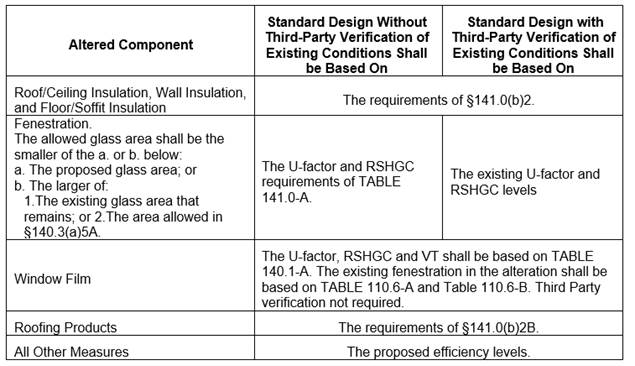
Energy Code, Table 141.0-E